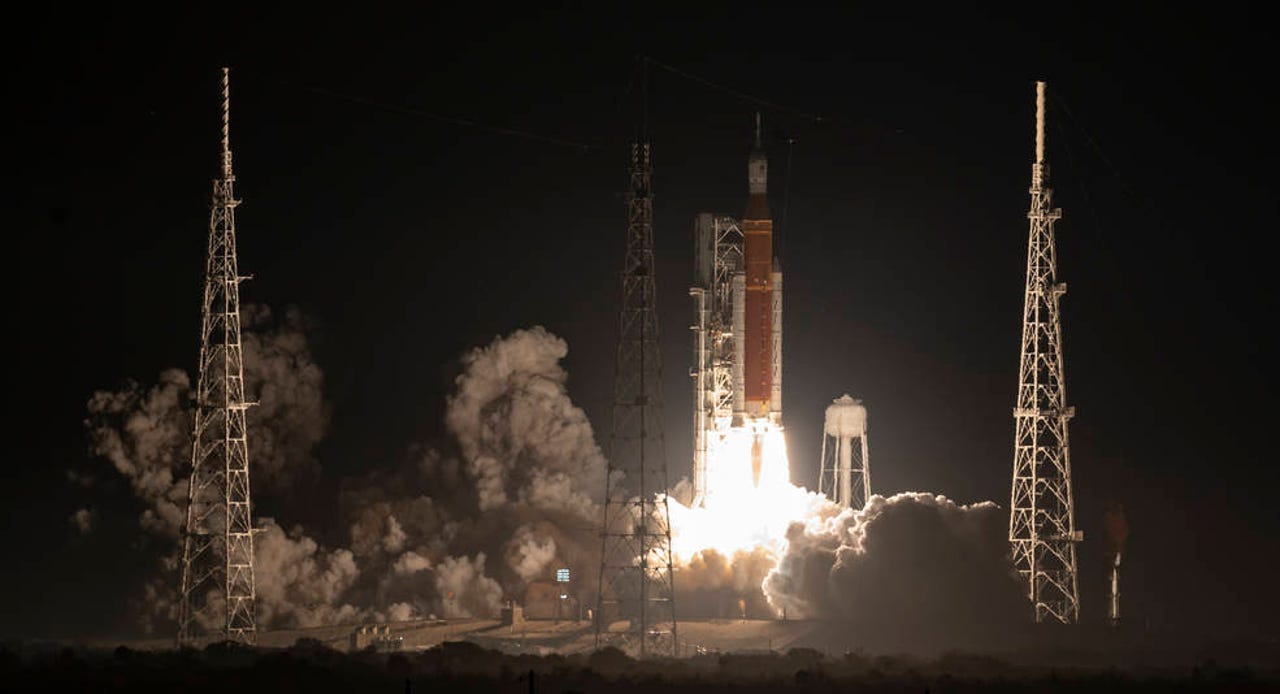
































NASA's Space Launch System rocket carrying the Orion spacecraft launches on the Artemis I flight test.
Image: NASA/Bill IngallsThe Artemis I Space Launch System (SLS), carrying the Orion spacecraft, has finally launched and is en route to the Moon.
Liftoff happened on time at 1:47 AM EST from Launch Complex 39B in Kennedy Space Center, Florida. The flight around the Moon and back gives NASA a chance to test the integrated systems in a deep-space environment before sending up crewed missions in the next decade. It also will test Orion's heat shield, and how it can recover the crew module after re-entry, descent and splashdown.
We are going.
- NASA (@NASA) November 16, 2022
For the first time, the @NASA_SLS rocket and @NASA_Orion fly together.#Artemis I begins a new chapter in human lunar exploration. pic.twitter.com/vmC64Qgft9
The Artemis I launch was meant to happen on August 16, two weeks ahead of the original schedule, but it was scrubbed after equipment failed to cool one of the four RS-25 rocket engines. A second attempt in early September was deferred due to a hydrogen leak in the fuel line to the SLS rocket's core stage. The third attempts across October and November were stalled by Hurricane Ian and then Hurricane Nicola.
The Artemis I mission sees SLS carry the Orion spacecraft into Earth orbit, where it will travel 40,000 miles beyond the Moon in a four-to-six-week mission.
Also:What is Artemis? Everything you need to know about NASA's new moon mission
NASA this week set its Capstone mission CubeSat on a near-rectilinear halo orbit (NRHO) around the Moon. It's the orbit the Gateway space station will be put into to support Artemis II missions and deep-space exploration. That orbit will offer Galaxy a continuous line of sight of Earth, enabling uninterrupted communication between Earth and the Moon.
About three minutes after liftoff, the service module fairing and launch abort system separated from the Orion spacecraft. The SLS core stage continued to fire until about eight minutes after launch, where it reached low-Earth orbit.
At 1:56 AM, the SLS core stage main engine cut off, and the core stage separated from the interim cryogenic propulsion stage and Orion spacecraft. At 2:24 AM, Orion's solar arras were deployed ahead of the "perigee raise manoeuvre" that raised Orion's orbit in preparation for the trans-lunar injection that sends Orion to the Moon.
"The perigee raise maneuver has been successfully completed. The interim cryogenic propulsion stage fired for just over 20 seconds to raise the lowest point of Orion's Earth orbit in preparation for the critical trans-lunar injection burn that will send Orion to the Moon. The trans-lunar injection burn is currently targeted for about 3:14 AM EST and will last about 18 minutes," NASA's Rachel Kraft said in an update.
NASA gave a final update at 3:44 AM ahead of the post-launch press conference scheduled for 5 AM EST on Wednesday from Kennedy.
"The interim cryogenic propulsion stage (ICPS) completed its approximately 18-minute trans-lunar injection (TLI) burn and the spacecraft has separated from the stage," wrote Kraft.
"Orion fired its auxiliary thrusters to move a safe distance away from the expended stage and the spacecraft is on its way to the Moon."
At that point, Orion separated from SLS's upper stage, and began flying with ESA's European Service Module, NASA administrator Jim Free noted on Twitter.
"We'll rely on the service module for the rest of our burns to keep us on track," he said.
pic.twitter.com/nrar6PGNdA
- Jim Free (@JimFree) November 16, 2022
 Горячие метки:
3. Инновации
1. Космос
Горячие метки:
3. Инновации
1. Космос